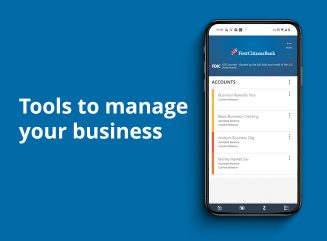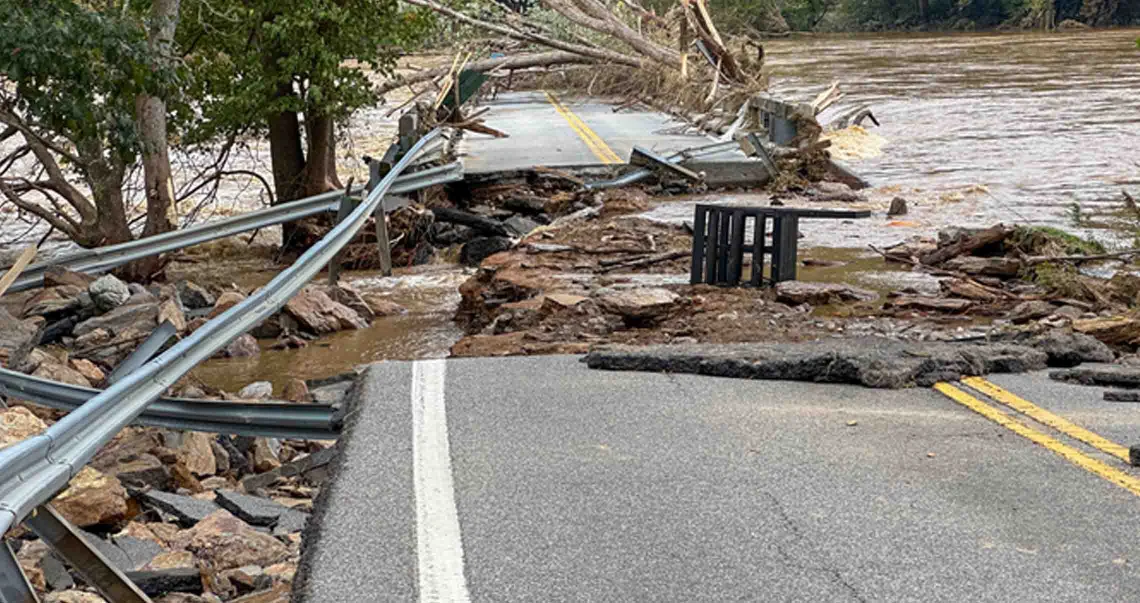Digital banking for business
Seamlessly access all of your accounts from one place with First Citizens Digital Banking for business.

Invest how you want, when you want, in real time with Self-Directed Investing.

Seamlessly access all of your accounts from one place with First Citizens Digital Banking for business.
We're committed to serving companies as they expand and succeed. The proof is in our success stories.
December FOMC meeting commentary: Available now
This month, the Fed lowered interest rates by another 0.25%. Read highlights and key takeaways from the Making Sense team.

William Connolly III
SVP, Senior Commercial Risk Advisor
It's no secret that natural disasters are occurring more often across the US. As these events become more common and intense, the costs to properly insure homes and businesses can increase significantly.

Although insurance costs have escalated with this surge in natural disasters, there are several tactics you can implement that may help you reduce the risks and expenses of insuring your business. Here are 10 disaster insurance strategies you can put to work at your organization this year. Each can help you demonstrate to insurers that your business is a lower-risk investment.
Regularly assessing your insurance needs and coverage with your advisor can help ensure that your costs are commensurate with your coverage. At a minimum, annual insurance reviews give you the opportunity to confirm that your policy reflects any new risk mitigation measures you've implemented during the year.
Engage with an experienced insurance advisor to help identify and rank the natural disaster risks that are prevalent in your location, such as floods, hurricanes, wildfires or earthquakes.
Once you understand the disasters that have a high likelihood of affecting your business, you can work with your advisor to assess the vulnerability of the following elements:
After completing your risk assessment, you'll have a clearer picture of the steps needed to safeguard your business from the interruptions, damage and potentially dangerous scenarios caused by natural disasters. Here are some straightforward tactics that are used to help reduce the likelihood of costly harm caused by disasters.
A fully documented business continuity plan is essential for your business to continue operations both during and after a disaster. When developing your continuity plan, it's a good idea to work with business department heads to ensure the plan is pragmatic, granular and comprehensive.
As you develop your continuity plan, address evacuation procedures, data backup systems and alternative supply chain options. Once it's complete, ensure the plan is well-communicated and made accessible to the right parties throughout your organization. In addition to safeguarding your operations, a comprehensive business continuity plan can demonstrate preparedness that may help lower your premiums.
With the emergence of technologies like cloud-based monitoring solutions, modern disaster warning systems have become less costly to buy and maintain. Commercial warning systems that have made significant technological advancements include flood sensors, fire detection and alarms, and earthquake early warning devices.
Reach out to your insurance advisor or agency to understand the most effective areas to implement or enhance the warning systems at your business.
Innovative Internet of Things, or IoT, devices can also provide enhanced risk monitoring at your business. These devices can scrutinize environmental data like vibration and air pressure changes and have proved to be cost-effective for mitigating risks using advanced predictive analytics. Talk with your insurance advisor to learn how innovative technologies can help safeguard your business.
Opting for higher deductibles on your business policies can help lower your monthly premiums. However, you'll want to ensure that you have sufficient cash reserves to cover the deductible that arises if you need to make a claim.
If your business has the financial ability to absorb some risk, you may want to consider self-insurance, captive insurance or parametric insurance programs to lower your costs. Here's an overview of the three options. They each have their own advantages and disadvantages, so it's best to speak with an insurance advisor to understand the best approach for your business.
Another straightforward approach to minimizing insurance costs is to avoid small or frequent claims. Submitting frequent insurance claims may cause your insurance provider to label you as a higher-risk client and subsequently raise your premiums. Try to make claims only during catastrophic events to help avoid increases in your total insurance costs over time.
Educating staff on your latest disaster preparedness and response protocols can help enhance the safety of your business for your clients and employees. By taking this step, you may reduce your business's exposure to natural disasters and demonstrate to insurers that you're a lower-risk policyholder, which can potentially lead to lower premiums.
Even with the prospect of more frequent natural disasters, these approaches can help you mitigate insurance costs at your business. Develop a close working relationship with an advisor who's well-versed in the nuances of commercial insurance. They'll become a valuable business partner as they work with you to strategically evaluate your risks and costs.
Our team of dedicated and experienced professionals can help you keep your insurance costs to a minimum while protecting your business from the increased risks of natural disasters. To learn more about risk management and understand the options for combating the rising cost of business insurance, reach out to our team today.



This material is for informational purposes only and is not intended to be an offer, specific investment strategy, recommendation or solicitation to purchase or sell any security or insurance product, and should not be construed as legal, tax or accounting advice. Please consult with your legal or tax advisor regarding the particular facts and circumstances of your situation prior to making any financial decision. While we believe that the information presented is from reliable sources, we do not represent, warrant or guarantee that it is accurate or complete.
Third parties mentioned are not affiliated with First-Citizens Bank & Trust Company.
Links to third-party websites may have a privacy policy different from First Citizens Bank and may provide less security than this website. First Citizens Bank and its affiliates are not responsible for the products, services and content on any third-party website.
First Citizens Bank is a Member FDIC and an Equal Housing Lender icon: sys-ehl.
NMLSR ID 503941

Treasury & Cash Management
Electronic Bill Presentment & Payment
Investment & Retirement Services
Community Association Banking
Equipment Financing & Leasing
Credit Cards
Merchant Services
Email Us
Please select the option that best matches your needs.
Customers with account-related questions who aren't enrolled in Digital Banking or who would prefer to talk with someone can call us directly.